This is going to be a long one, but I want to get the Weatherlight Saga out of the way. It's sort of like 1990s superhero comics: full of iconic characters and landmark events, but much more impressive in retrospect than in its execution.
___________
So—here we are at the Urza block, consisting of
Urza's Saga (October 1998),
Urza's Legacy (Feburary 1999), and
Urza's Destiny (June 1999).
I almost regret giving up Magic: The Gathering when I did. Had I kept on for just another year, I would have born contemporary witness to Urza's return to Magic—which we could also say is his first real appearance—and it would have blown my mind.
What happened, I think, was that Wizards of the Coast was simply responding to players' feedback. The new creative direction wasn't as warmly welcomed as the company hoped, so it scuttled the original plans for the Weatherlight Saga and gave Gerrard and friends the old vaudeville hook. They'd be back later, after fans had a long break from them. But that left the creative department in the position of figuring out a new angle. My guess is that they were reluctant to cancel the Weatherlight story outright, but needed to find out some way of getting themselves out of the corner into which they'd painted themselves.
So they brought back Urza. It made sense: he'd been Magic's most important character since before the game even had characters. Antiquities, the first expansion set with a self-contained story told in its cards, cast an outsized shadow by virtue of being Dominaria's ur-narrative, and Urza was the unseen mythical figure at its center. Anyone who'd played the game for any length of time knew about Urza. There probably wasn't any better way to save face with the people grumbling about Gerrard than by swapping him out for Urza.
It's possible that Wizards saw a convenient opportunity for brand synergy. After ending its relationship with publishers Armada and HarperPrism, Wizards releasing in-house Magic novels. The first of these was The Brothers' War, published in May 1998—a month before Exodus shipped. The decision to have it written was very probably made before Weatherlight's planned story was scrapped, and having it in the pipeline might have been the determining factor in the next block's creative direction.



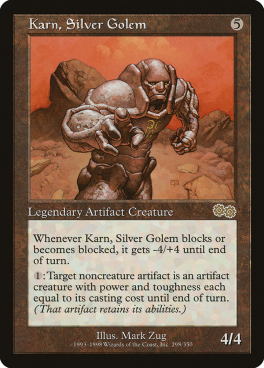
By the way, Darth Vader built C3PO Urza built Karn.
Even if I'd kept playing Magic, I'm not sure if I would have read The Brothers' War—I never read any of the HarperPrism books, after all—but perhaps it would have caused enough ripples that I'd have heard about how it altered and added to the lore. The new, official story of Urza and Mishra's feud ended with a direct confrontation between the brothers in Argoth. After discovering that Mishra has either been Phyrexianized or replaced by a Phyrexian construct, Urza goes nuts and and detonates the Golgothian Sylex artifact (top), blowing up the entire continent. (Don't ask how a Greek drinking vessel is supposed to operate like a hydrogen bomb. The card does what it does.) In doing so, he activates his latent planeswalker spark and survives the blast with his new god-powers.
The next novel, Planeswalker, came out in September 1998—one month before Urza's Saga debuted—and tells the more of the story behind the cards. Book three, released in April 1999, covers the rest of Urza's Saga and the events of Urza's Legacy. Book four, Bloodlines, corresponds to Urza's Destiny.
This was a tectonic shift in terms of how Magic constructed its lore. Ages and ages ago, when I wrote all those essay-like things about the Final Fantasy series, I went on at some length about how JRPGs drove a wedge between their ludological (ugh) and narrative aspects: there's the part of Final Fantasy X where you run around fighting random battles, collecting items, and building up your characters, and there's the part where you put down the controller and watch your characters talk to each other, and never the twain shall meet. (Two counter-examples of this design style are Blood Omen: Legacy of Kain and Portal.) But this is a bit like what Magic begins to do here: there's the game product and the story product, each sold separately as different media. The game product gives visual form to the setting, the cast, and the action; it supplements the lore and reflects the metaplot—but in order to get the complete story behind the cards, it becomes necessary to read the books.
(Full disclosure: I have only skimmed the books. And only some of them.)
Fortunately, there's still a lot we can examine here, even if we're (mostly) limiting ourselves to the collectible cards and how their text, illustrations, and play mechanics do the work of worldbuilding and mythologizing.
First thing's first: since Urza's Saga features "storyboard" cards akin to the ones we've seen in Tempest and Stronghold (though they're encounter far less often), it might be worth looking at a few of them to catch up what Urza's been up to since Antiquities. In brief: after the debacle at Argoth, Urza's a bit sore at Phyrexia for manipulating, corrupting, and possibly murdering his brother. Now that he's a nigh-immortal, dimension-hopping godling, he intends to pay a visit to Robot Hell and settle accounts. It doesn't go well for him.
The green cards of Urza's Saga depict Argoth during the last days of the Brothers' War. Black is mostly set in Phyrexia (though its cards seep into a couple of other places), which Urza attacked to avenge Mishra. White takes us to Serra's realm, where Urza convalesced after Yawgmoth sent him packing. Blue is the Tolarian Academy, which Urza founded in order to train wizards and artificers to operate as an R&D department in his crusade against Phyrexia. Red cards are centered in the Shiv region, where Urza discovers a massive "mana rig" left over from the high-tech Than Empire.
So, the chronology of Urza's Saga is: green → black → white → blue → red. Artifacts are wild.
There's some stuff to like here. Urza and Mishra's plundering of Argoth was a small but dramatic component of Antiquities, and I enjoyed seeing it expanded on. Serra's realm gives the angelic planeswalker (named in the original set, canonized in Homelands) her due at last, making her the absolute ruler of a world she made and populated with her angels; the quotes from "The Song of All" characterize it not in terms of its folkways or landscapes, but its ideology. Blue's focus on a wizards' college gives those cards a "school days" vibe that's entirely novel to Magic, and faintly redolent of Harry Potter. (The series' first book had been published a year earlier, but that doesn't necessarily mean it influenced the set's development.) Red, sadly, gets shorted by looking pretty much the same as the red cards in any other set: fire, rocks, lizards, goblins, and violence, and sometimes Urza's there, too.
And black...we'll talk about that in a bit.




The next two sets move things around a bit. By the time we get to Urza's Destiny, white has relocated to Benalia, where the refugees of Serra's Realm have resettled. Red goes from Shiv to Keld. Black returns to Rath, which is (and always was) under Phyrexian management, created as a staging area for a full-scale invasion of Dominaria. Green is set in Yavimaya, and blue is still at the Tolarian Academy. I'll leave it to the continuity nerds to figure out the chronology, but we're getting pretty close to the present day.
Urza's Legacy and Urza's Destiny are each more unified in time than Urza's Saga, and I'm guessing this is a consequence of the card releases catching up with the novels. Urza's Saga corresponds to the events depicted in three different novels, while Urza's Legacy and Urza's Destiny are each paired with one. Given than the small sets are each about four-tenths the sizes of Urza's Saga, it makes sense, and it's understandable that they should be less epic in their scope.
Still—something about Urza's Destiny and Urza's Legacy leaves me feeling a bit cold. It might be my imagination, but they seem somehow skimpy.
I remember when Alliances came out. I bought the boosters, integrated the cards into my decks, and got acquainted with the lore in the process. My experiencing it in this way might explain why I feel like it did a much better job explaining itself than Urza's Legacy (just to focus on one of the two). I remember I didn't spend a whole lot of time wondering about the circumstances that compelled Ice Age's rival nations Balduvia and Kjeldor to bury the hatchet; everything about the set bespeaks turbulence and change. It seems to me that the designers knew they didn't have to coordinate with a novelist (and avoid stepping on his or her toes, or spoiling the plot), and couldn't count on there being any complementary literature that would fill in the gaps. Alliances is riddled with vagaries, but its story seems to me as complete as could be hoped for, given the space the creative team had to work with.
Urza's Legacy is also vague. Let's take the Kerrick arc as an example.
If our only source is the cards themselves, here's what we know: as a result of the Tolarian Academy's disastrous experiments with time portals (treated in Urza's Saga), there's a fast-time bubble lingering on the island. A Phyrexian sleeper agent named Kerrick somehow got trapped inside. Experiencing time at a much faster rate than the outside world, Kerrick builds a fortress and an army inside the rift, and at some point he stages an attack on Tolaria.
When I looked at the index on MagicCards.info for the first time, I felt like I was missing something. Who's
Kerrick? What was the result of his attack on Tolaria? What else was inside the time bubble aside from carved rocks and monsters? How did Kerrick and/or his army get out of the bubble, since they were apparently trapped in there?
Again, I probably wouldn't be so critical if I was opening booster packs and playing games at Hero Town with the other nerds back in 1999—but I do feel like the story is vague because it was never meant to stand on its own, but to supplement (or advertise) the book, which contains the real story.
All of this, and we still haven't said much about the title character yet.
Antiquities introduced Urza as one of two belligerents in a war that ravaged the world in the distant past. Even though he was characterized as the nicer of the two brothers, his role in despoiling Argoth made clear that he was no less ruthless in working toward his goals than Mishra. When we meet him in the (painted) flesh in Urza's Saga, he seems more or less on the level. In Urza's Legacy, we have every indication that he's still on the up and up.
But in Urza's Destiny, we find him on the verge of alienating his most important allies. We're not told precisely what it is that his colleagues Barrin and Rayne take issue with (but if we read the books, we'd know it was eugenics and genetic engineering—the eventual product of which was Gerrard), but at this point he's clearly putting his mission above every other consideration.
I have mixed feeling about the read the books era of Magic lore, but the novels are mandatory for understanding what Urza's about. The cards allude to it, but the full extent of Urza's callousness and obsession are barely touched on in the flavor text. He's an amoral sociopath with godlike powers who just happens to be channeling his genius and energy into averting the end of the world, no matter how many peoples' lives he fucks up along the way.
In light of the planeswalker protagonists of modern Magic, it's amazing that Wizards made the OG hero of its flagship property such an inveterate son of a bitch. If the Gatewatch is like the Avengers translated into a fantasy setting, then Urza is more like Captain Ahab as a planeswalker. Next to him, antihero necromancer Liliana Vess seems like the kind of person who cranks up the volume, shuts her eyes, and luxuriates in mouthing the lyrics whenever a Smiths song comes on. With a few exceptions, today's planeswalkers act like a bunch of adolescents—a trend in popular media that I'm inclined to blame on Joss Whedon, JJ Abrams, Alex Kurtzman, JK Rowling, the Walt Disney Company, and my own miserable millennial cohort. Urza, on the other hand, is the ultimate adult in the room. He's mad, bad, and dangerous to know, but he's the only person capable of saving Dominaria from a Phyrexian doomsday, and he does not take this responsibility lightly.
After years of glimpsing only the occasional mechanical beast or infernal gadget that made its way to Dominaria or Rath, the Urza block finally takes us into Robot Hell to see what it's all about.
I think I mentioned in
the last post that the original plan for the Weatherlight Saga involved making Sisay and the Weatherlight a consistent background presence for a while, and then revealing their importance to the big picture. That idea was scrapped—at least where Sisay was concerned.
There are four cards in 1994's Antiquities named for Phyrexia and for Yawgmoth. None give much indication as to what either of these names mean, except that Phyrexia is a place where oil rains from the sky. Two years later, Phyrexian tech is made the subject of one of several subplots in Alliances. Between 1996 and 1999, Phyrexian artifacts and the occasional black spell are a consistent but minor presence in Magic, reappearing without any fanfare while Jamuraa goes to war and Gerrard goes on an adventure to rescue his friend and recover the artifacts that can defeat the Lord of the Wastes.
And then we come to the Urza Block, where we learn that the Lord of the Wastes is none other Yawgmoth, and that Phyrexia poses an existential threat to Dominaria that makes Lim-Dûl and Kaervek seem like infants by comparison.
(I remember sending an email to Wizards of the Coast around 1996—it must have been either a little before or after the release of Alliances—asking about Phyrexia. Maybe just, "what's the deal with Gate to Phyrexia?" The answer I got was surprisingly thorough: nine concentric spheres of metal, oil, fire, and darkness, with a god called Yawgmoth at the center. This is just to say that the lore had been devised at least a few years before it went live.)
Elaborating on something that had been previously left to the imagination invites risk. The general quality of X-Files' "mythology" episodes is inversely proportionate to how much we know about the Syndicate's collusion with the alien colonists. The evocative mystery is usually more interesting than the revealed object. From the beginning, Phyrexia intrigued Magic players because we knew so little about it, despite the frequency with which its tech appeared. It would have been so easy for Magic's creative team to fumble the delivery, to deliver a vision of Phyrexia that fell far short of fans' ideas of what it might be.
But they hit it out of the damn park. Even without the additional context and development provided by the novels, Phyrexia is brilliantly realized in the cards themselves.
Phyrexia is an ecosystem. An ideology. A totalitarian state. A religion. And so happy! Look at the Phyrexian cards and count the smiles. They're really into being being part of a god-built world-machine made for genocide. The ghouls and horrors clearly love their work, and don't mind if they have to die for it. Phyrexia smacks of the ecstasy of fascism, which has more than a little to do with why Yawgmoth & Fiends became Magic's most popular villains. The Phyrexians' enthusiasm is disturbingly infectious.
As it happens, old heads don't remember the Urza block fondly. It exploded the lore, sure—but Magic is first and foremost a
game, and the Urza block ruined it. Each of its three sets contained cards
so busted that a deck that couldn't consistently have a win locked in by the second turn simply wasn't viable. Fans coined the term "Combo Winter" to describe the state of the metagame at that time. A lot of people just weren't having fun anymore.
So Wizards banned a whole bunch of cards from tournament play and endeavored to give the next batches a more reasonable power level. Unfortunately, the developers erred way too far in the other direction, producing possibly the worst block in the game's history, and irritating fans even further. (Incidentally, this was about when the Pokémon CCG started outselling Magic.)
But we're talking about lore and worldbuilding here. And in this regard, the Masques blocks is...awkward.
The first set in the block was never supposed to be called Mercadian Masques (October 1999). Apparently it occurred to somebody at Wizards that maybe more people would buy and read the books if their titles matched the names of the expansion sets they supplemented, and the title of the upcoming novel was already locked in. The cards were compelled to follow suit. Awkward.
Probably a better name for the block would be something like "Interludes" or "Before the Storm" or something like that. Lore-wise, the block's purpose is to bring us back to the present, let us get our bearings before Phyrexia invades Dominaria, and show us what's been happening around the planar neighborhood after the Weatherlight absconded from Rath.
Mercadian Masques follows Sisay, Gerrard, and friends after they blow through the Rathi portal and crash land on a plane called Mercadia. Stuff happens; people misunderstand each other, Starke dies, Volrath escapes, there's some sort of dragon god named Ramos that maybe does something important (but you have to
read the books to find out what), the Weatherlight gets repaired, and our heroes go flapping back to Dominaria. We don't need to get into the specifics here.
I'll say this for Mercadian Masques: it manages to bring the Weatherlight crew back to the fore without making their presence overbearing. We see just enough of Gerrard to be happy he's around, to get a rough idea of what the Weatherlight crew does during its stay in Mercadia—although most of what happens during what must be the climax (because the art shows things blowing up) is carefully danced around. (Can't let the trailer spoil the entire movie, can we?)
But since the adventures of Team Weatherlight aren't taking up so much space anymore, a new Magic set situated on a new plane can do some good old-fashioned worldbuilding. It's about time.
So let's see here. Ice Age had an arctic setting. Mirage had a tropical setting. Rath was dark and stormy; the Urza block had, uh, a historical theme. What gimmicks are left? An island of giants? A pipe maze?
Oh! How about a city?
A city plane! That's the ticket! An urban nexus of marketplaces, sketchy alleys, administrative buildings, ports, and all the other fixtures of metropolitan commerce! Bureaucrats instead of wizards! Merchants instead of soldiers! Bouncers and enforcers instead of zombies and horrors! It's a whole new flavor for a whole new plane!
...Except when it isn't. The city-themed cards are sort of neat, but an almost equal amount of pervading generic fantasy stuff dilutes the effect. (
See for yourself, if you want.) The art direction doesn't help much, either. If the creative department was going for maximum homogeneity then they really made something they can be proud of. Visually, Mercadian Masques is so monotonously nondescript that you could be forgiven for not guessing that somebody intended for it to help carry a motif.
Okay, okay. But get this: Mercadia has more to it than its erratic metropolitan setting. All of Mercadia is erratic. It's a topsy-turvy kind of plane! They built the capital city on a mountain that's narrowest at its base and broadest at its summit! It's upside-down! How quirky!
And if you can even believe it, Team Weatherlight's freaky Friday in Mercadia gets even zanier!
You see? The goblins are smart! The witches are men! The trolls are quadrapeds! The rebel soldiers ride giant cats instead of horses and the merfolk have legs (not pictured, but take my word for it)! The kraken is...whatever that thing is! It sure doesn't look like any kraken I've ever seen before! Yes, Mercadia is truly a koo-koo nutty world!
...Except when it isn't, which is most of the time. The upside-down fantasy tropes are outnumbered by their rightside-up, readymade counterparts by a wide margin. I can't speak for anyone else, but if I hadn't read somewhere that the creative team was trying to make Mercadia seem inverted and weird, I certainly wouldn't have picked up on it. The whole thing is purely cosmetic, anyhow: Mercadia's wacky smart goblins look like green-faced PBS news anchors, but there's no functional distinction between them and the goblin cards printed in any other set. (Some good counterexamples would be Zendikar's jungle vampires, Innistrad's haute monde club kid vampires, and Ixalan's conquistador vampires, all of which have some mechanical idiosyncrasy in addition to their distinguishing superfices.)
In short: Mercadian Masques is half-baked and awkward, and future sets outstrip it in everything interesting that it tries to do.
Nemesis (February 2000) takes us back to Rath, where occurrences are transpiring and happenings are doing.
Since Rath was introduced during Magic's short-lived experiment in linear storytelling via collectible cards, the Tempest block's acute focus on its characters left its setting undeveloped. At 143 cards, Nemesis hasn't much space to give the plane more character, and the designers apparently weren't eager to try.
Multiverse in Review says the Nemesis novel is one of the best Magic books ever printed—but whatever made the novel interesting sure didn't make it into the set.
That's Ertai getting tortured in Viseling (above). Just in case you forgot he existed.
Since I'd rather not synopsize the myriad intrigues of the plot (to which only people who've read the book are privy), the only other thing that warrants mention involves Crovax and Volrath.
To recap: Crovax, the Weatherlight's angstiest crew member, became a vampire and turned villain. Volrarth, Rath's ruling evincar, disguised himself as Starke's daughter stowed away aboard the Weatherlight, following Gerrard and friends to Mercadia—for some reason. Inexplicably, Volrath didn't tell anybody he was leaving, and he comes back home to find that his bosses in Phyrexia are already accepting applications for a replacement evincar. Crovax, now pumped full of Phyrexian muscle milk, throws his hat into the ring.
And so the dark mastermind of the Tempest block meets his ignominious end. The name given to Volrath's legendary card adds insult to injury. He's not not "Volrath, the Diabolical," "Volrath, Terror of the Stronghold," but "Volrath, Not What He Used To Be." Between the name and the flavor text, Volrath's card—his very in-game identity—permanently defines him in terms of the he time sneaked out of the office without leaving a memo and came back to be told that if he wanted his job back, he'd have to apply for it. (Again, I have to wonder what the Weatherlight Saga's original outline had in store for Volrath. One imagines it wouldn't have been so anticlimactic as what he got.)
And Crovax? Putting aside how grossly, cartoonishly evil he is now, notice that his new card isn't called "Crovax, Ascendant Envicar," but just "Ascendant Evincar. This was the first time any character got a second legendary card, and the developers worried that players wouldn't know how to properly apply the "legendary rule" if two cards with "Crovax" in their names were on the table at the same time. As a result, Nu-Crovax's in-game identity is a snapshot of him waiting for his new business cards to arrive from Staples.
Also: is anyone else distracted by the discrepancy between Ascendant Evincar's modest power/toughness specs and the massive powerup Crovax is supposed to have received? Crovax, The Cursed hits the table as a 4/4. Ascendant Evincar is a mere 3/3.
While Tempest was being developed, there was a lot of agonistic back-and-forth about
Greven Il-Vec and
Vhati Il-Dal. In the story, Greven kills his underling Vhati; but on the
table, Vhati's ability knocks Greven on his ass. How did
that make sense? The issue was settled by making the player who uses Greven kill off another of his own creatures, acting out the scene in the story where
Greven pitches Vhati overboard. By the time Nemesis was in the atelier, nobody cared about this kind of thing anymore. Not only is Ascendant Evincar weaker and less durable than Volrath the Fallen, but Crovax's ability actually makes Volrath
stronger. There aren't many in-game scenarios where Ascendant Evincar can overpower Volrath the Fallen and survive without a lot of assistance, and Volrath's own ability thwarts many of the usual shenanigans.
Awkward. The whole Masques block is awkward.
Now we stagger into Prophecy (June 2000)—possibly the only set that longtime Magic players revile more than Homelands, on the basis that its cards are deliberately, strategically designed not to be any fun to use. Its story is about Keld invading Jamuraa—for some reason. (Read the book.)
I reckon that if I'd hung on through Weatherlight, the Tempest block, and the Urza block, Prophecy would have finally made me quit. I loved Mirage, and would have been excited for the game to return to Jamuraa—except that this isn't the Jamuraa I remember. Erstwhile art director Sue-Ann Harkey, who developed Mirage and Visions' aesthetic, was long gone. Whoever had been on writing and lore detail in 1996 had either followed her out, or was otherwise at a loss for inspiration. The Masques block saved the blandest for last, and the creative department outdid itself by returning to Magic's richest setting and making it bare and boring. Seriously, that's no small feat.
Since I already had my "is he on the spectrum?" moment with Crovax and Volrath, I'd rather not spend twenty minutes harping on the lousy art direction. Let me encourage you, then, to browse Scryfall's card galleries to see what I mean. Here's
Visions, and here's
Prophecy. Compare them for yourself.
I won't name names, but it looks like the art directors forgot that Jamuraa is a sunny tropical place—just like they forgot that Rath is supposed be dark and stormy. In general, Nemesis' palette is lighter than Prophecy's, and...well, like I said, let's not dwell on it. They didn't do a very good job, is all.
Moreover, whichever part of the creative team was on writing detail saw no reason to reference any of the places introduced in Mirage. Zhalfir, Femerf, and Suq'Ata are never mentioned, let alone the Mwonvuli Jungle, Mtenda Plains, the Kukemssa Sea, et cetera. The familiar voices of Mirage/Visions (Hakim, Azeworai, Afari, the anonymous poet of the Love Song of Night and Day, et al.) don't return. The only characters to reappear are Terferi and Jolrael, and I'm inclined not to count Teferi at all; he's quoted in just a single card, and at this point, that's practically nothing.
Jolrael, however, gets a legendary creature card (above), and she looks kind of familiar.


I'm sure that when Kaja Foglio took the commission back in 1994, her instructions for the card that would become Spirit Link weren't much more descriptive than "show a mental link between a wizard and a creature," or something along those lines. (This was back when the art department played things pretty fast and loose.) So Foglio followed her creative whim, painting female wizard and a white batlike-catlike creature. When the card was reprinted in the core set's Fifth Edition three years later (a month after Visions' release), somebody tacked on some new flavor text: a quote from Jolrael, acting as a brief denouement to her role in the Mirage/Visions affair. For whatever reason, the idea that the woman quoted and illustrated on the card Spirit Link crystallized in somebody's mind, and Prophecy makes the association official.
Odd that this didn't happen more often. Jaya Ballard ended up looking nothing like the woman from
Pyroblast, after all.
In conclusion: this was more than I ever wanted to think about the Masques block and I regret every decision I've made in my life up to this point.




But on we press! We've come to the culmination of the saga six years in the making! As its name suggests, Invasion (October 2000), is about Phyrexia finally getting off its collective duff and mounting a full-scale assault on Dominaria. Exciting stuff! (Why did Yawgmoth need like 4000 years to prepare, you ask? Read the books.)
Hmm. Since we're already familiar with the setting, the scenario, and most of the characters in play, there's really no point in any drawn-out exposition. We'll just add that the Invasion block was a breath of fresh air after the unmitigated fiasco of the Urza block and the dullness of the Masques block.
Let's look at (some of) the story as it appears in the cards:
Okay, yeah, there's a lot going on here, and plenty that I missed. To recap: Urza is pleased with himself and stomps around in a mecha. Teferi reluctantly gets involved. Another Weatherlight crew member bites the dust. The long-suffering Barrin goes ballistic. Gerrard fights Tasbo Tavoc, the Phyrexian general leading the invasion. Dominaria's natural agencies unleash the kavu, elephant-sized predators that had been lying dormant for millennia. Benalia gets blowed up. The necromancers and witches of stanky Urborg join the effort to repel the invaders. The merfolk nation of Vodalia seems pretty indifferent to the whole thing. The allied peoples of Dominaria prevail against the first wave of the attack.
Perhaps you have questions. How did Hanna die? Didn't the Vodalian nation collapse back in Fallen Empires? Why is Jamuraa conspicuously absent? How did Gerrard manage to defeat Tsabo? At this point, is it even necessary to tell you to read the books?
I wasn't too concerned about the order when I pasted the card images in, and it probably doesn't matter. The shit's hit the fan, Phyrexian monsters and machines are swarming across the planet, and all of our heroes are running every which way. Invasion does an admirable job conveying the planetary scale of the carnage and the fog of war—previous Magic sets depicted armed conflict (it's a game about fighting, after all), but none were so palpably frantic as this.
Aside from the whole "climactic battle to determine Dominaria's fate," the Invasion block has two prevalent themes: diversity and dragons.
First: dragons. Debuting a new quintet of tricolored legendary dragons (the first such cycle was introduced way back in Legends) made perfect sense for a set with an emphasis on multicolored cards. But in terms of the story that's being told here—maybe now wasn't the best time to introduce a big subplot about the awakening of five primeval dragons that want to reassert their dominion over the world, totally incidental to the war already being fought.
The diversity motif is more obvious. In the story, all of Dominaria's myriad nations and races must work together if there's to be any chance of repelling the Phyrexians, and the mechanics of the Invasion block generally favor multicolor decks. It's chock full of cards that reward players who run multiple colors and punish opponents who use single-colored decks; it has multiple cycles of dual lands, both ally- and enemy-colored, and more gold cards than any set since Legends. The "diversity makes us strong"
guildmages of Mirage have their functional successors in a cycle of
apprentices and
masters.
If there's a flaw in the block's execution, it's the underrepresentation of the invaders. Here and there we see cards of different colors representing the consequences of the onslaught, but in terms of the opposing "armies" represented by the creature cards, the Phyrexians appear hopelessly outnumbered, contrary to what the narrative says. Phyrexian creatures have always been black—limiting them to one of five possible color identities—and now they have to share space with the zombies and necromancers of the Dominarian coalition.
It also doesn't help that when the Phyrexians aren't the focus of an illustration, they tend to be rendered as blurry, grayish-brown humanoids, or washed-out, generic-looking killbots in the margins. Here's what I mean:
I get the sense that there wasn't much of a style guide for the Phyrexians. Artists tasked with depicting some particular abomination of metal and flesh (see above, left column) gave it a distinct look; ones tasked with providing the art for cards like "human knight," "elvish wizard," or "primeval beast" (see above, right column) were probably told to show them fighting with a robot or some zombie cyborgs or whatever, and they painted them as though they were supernumeraries. They often seem rather more anemic than terrifying.
I'll
probably tire of this
way before we get to it, but
War of the Spark fixed this issue, making sure that the evil invaders were amply represented, and not restricted to just one color in the wheel. These invaders were basically a zombie horde plated in cerulean-colored metal—a canny design choice that helped them to leap out of an illustration even when they weren't the focus.
Lastly, I'd like to give a tip of my hat to Invasion's unsung hero: the villain Tsabo Tavoc. I haven't counted all the cards in which she appears or is quoted (it's late and I'm tired), but she's without doubt Invasion's strongest presence.
Phyrexia has always been a composite menace—after all, its ideology has never prized individualism—but here it needed a spokesperson. A face and a voice. Tsabo Tavoc, the general leading the onslaught, puts in overtime making the Phyrexian host seem like a credible threat. From what we can see in the cards, she's having the time of her life: flying around Dominaria, murdering people, setting off biological weapons, raising the dead as zombies, and gloating about it. (I wish I enjoyed my job half as much as any given Phyrexian.) If you're fluent in Magic rules text, you'll see that her card (above) is designed to kill heroes. None of the Weatherlight kids can target or damage her, and she can make any one of them disappear per turn. Strong design.
In Planeshift (February 2001), Phyrexia proceeds to phase two: merging Rath with Dominaria! (How does that even work, you ask? Read the books.)
Rath superimposes itself onto Dominaria, dropping Crovax, Volrath's his Stronghold, and the armies of Rath into the fray! Crovax commits his most heinous act yet: killing off Tsabo and depriving the rest of the story of a clear and present antagonist! Urza sticks a bunch of planeswalkers in mecha and they all go to Phyrexia! The Predator crashes into the Stronghold and explodes! Greven il-Vec dies offscreen! Something something primeval dragons, something something Keldon Twilight! Then Gerrard is somehow in Phyrexia with Urza, and Urza decides he's on Team Yawgmoth for some reason!
Seriously, if you don't read the books, the narrative in Planeshift is pretty hard to follow.
The Nine Titans arc is goofy as heck, but interesting as an exercise in cleaning house. We won't go into detail about the other eight planeswalkers whom Urza recruits to help him blow up Phyrexia, but a majority of them are from the Armada comics. Taysir and Daria were quoted a few times in Homelands, but were much more prominent in the comics' lore than the cards'. Tevesh Szat had a single creature named after him in Ice Age, and was then written as a major villain in the Ice Age comic. Kristiana of the Woods was exclusive to the comics. Of these four, only Daria appears or is mentioned in the set, but each of them gets killed off in the novel. I guess it's a good a way as any of sweeping aside the third-party properties for good, preempting further emails from fans who keep asking "what happened to Taysir? When is Daria coming back? Is Tevesh Szat still around?"
Speaking of recurring characters, Ertai's here! Remember him? We last saw him in Nemesis, getting tortured on Rath after the Weatherlight left him behind. I'm sure Ertai understands that if Gerrard stopped to pick him up at the portal's control panel, they all would have been captured and killed. They didn't have any other choice. (And Urza, uh, must have had more important things to do.) Ertai's a big boy; certainly he's not holding any grudges.
Ah, well. Crovax may have won the audition to become Rath's overlord. but at least Ertai 2.0 was allowed to have his name at the top of his card.
Speaking of legendary creature cards: now that the final chapter of the Weatherlight Saga was nigh, the designers had no time left to dilly dally. If the remaining crew members weren't represented in cards by by the next set, there would be no more chances to do so (is what
everyone believed once).
Hmm. After such a long wait, Gerrard seems just a
smidge underpowered for the saga's main character, the guy Urza genetically engineered to repulse the Phyrexian invasion. This is something else Magic would get better at later on.
Nobody was underwhelmed when
Avacyn finally appeared in the Innistrad block. (For the jargon illiterate: Gerrard's card is one that you scrutinize for a while and eventually decide that, yeah, sure, it probably has its uses. Avacyn's card is one that you scrutinize for a while because you feel you've got to be missing something, since there's no way it should be able to do what it it says it does.)
With Apocalypse (June 2001), the plotline that dominated Magic for four years comes limping across the finish line. By this point, it's like the creative team had wrung its collective brain dry of ideas for "Dominaria vs. Phyrexia" themed cards, the stable of artists was getting tired of painting weltering battle scenes between the defenders of Dominaria and Phyrexia's necrotic (yet bland) machinery, and the art directors were getting tired of looking at them. For a set that's meant to function as the final chapter in this very particular and significant event in the lore, Apocalypse comes across as incongruously nonspecific. "Okay, what, another creature card. Great. This one's green? Let's call it a bobcat. Tell Heather to paint a picture of a bobcat. I'll write a blurb about how it's a bobcat. What's next? A white creature card. This one's a lynx. Make it a ghost lynx, though, and tell Heather to paint a picture of a lynx that's also a ghost." Fatigue had evidently set in. (There might have been something else going on behind the scenes, but we'll get into that next time.)
Anyway: the story of Apocalypse. See if it makes any sense to you.
I suppose you were hoping to
see Yawgmoth, or to get some idea of what The Legacy (remember that?) actually
did after all the fuss over it, or learn how Magic's ultimate evil was defeated in the end. Well: that's Yawgmoth in the background of Last Stand (he's the cloud), The Legacy does
something, and Yagwmoth was defeated because of Gerrard's sacrifice, because it was his destiny. Do I need to draw you a diagram? What more do you
want?
I actually did
read the book (well, some of it) a while back, and I haven't the foggiest recollection of what the hell happened at the end. I'll resort to quoting the summary from
Multiverse in Review:
While all this is going on the remaining [planeswalkers], Freyalise, Lord Windgrace, Bo Levar and Commodore Guff, have been going around and detonating the bombs they hid throughout Phyrexia manually, as Urza destroyed the master switch when he switched sides last novel. They succeed, but as they watch Phyrexia collapse in on itself Guff reveals that he knows the future because he edited the story, and lets slip that none of this matters since Yawgmoth is moving into Dominaria anyway. Just before the lava consumes it, he emerges from the portal inside the Stronghold in the form of a gigantic cloud that kills whatever it touches and resurrects the dead.
Hmm. I'm starting to get an idea of why I didn't commit any of this to memory.
In the end the whole book devolves into a series of failed plans to stop Yawgmoth. First the Weatherlight crashes a Phyrexian ship into the Stronghold volcano to prevent Yawgmoth from escaping it. But that fails as he just oozes around it. Then Urza suggests a really bizarre plan, saying that the Legacy artifacts contain many worlds, while Gerrard somehow contains many heroes. He wants to crack open both, destroying half of Dominaria by letting out those planes, and then having the army of heroes that would spring from Gerrard's head reconquer the other hemisphere. Sisay thinks it's all nonsense, saying Urza just came up with another Sylex Blast. So instead they go with another plan, which involves cracking the Null Moon, which has been collecting white mana ever since Thran times. They fly through it, sacrificing the Weatherlight to channel the energy into a Yawgmoth-killing blast... only for that to barely make a dent in him. Then Gerrard and Urza come up with a post-last-ditch idea, rip Urza's eyes out and place them in Karn's chest. Which results in a big light and thus Yawgmoth is defeated. Somehow. All over Dominaria the Phyrexian forces go catatonic after the death of their leader, allowing even children to kill them.
The ultimate secret of Magic: The Gathering lore is that in spite of how involved and esoteric it is, how intimidating it might seem to the novice, and the avidity with which its fans talk about the story, a lot of it is incredibly stupid. And it's usually at its most idiotic when novels are involved. Most of the time, the archetypes and episodes of a mythos speak much more eloquently for themselves when they're not made to coagulate within in a delineated narrative.
I'll elaborate on this thought next time. (Postscript: it became a separate post.
See here.) I need to go to bed.




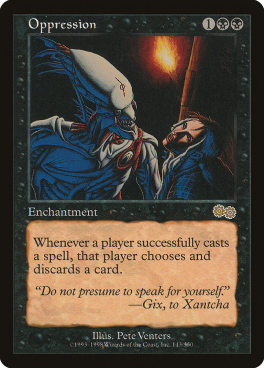








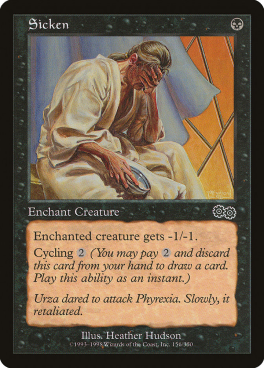






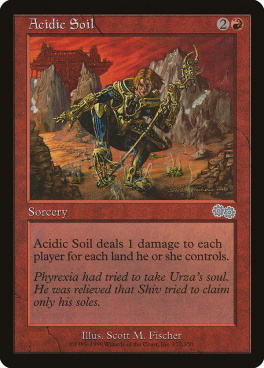








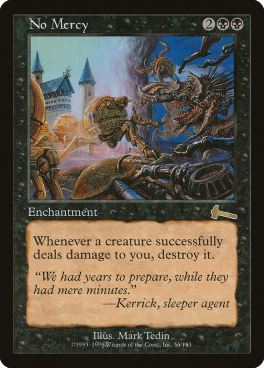







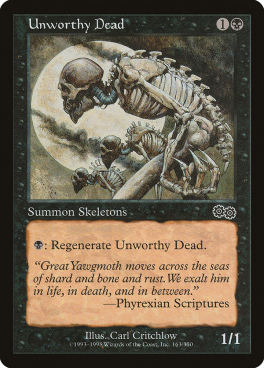


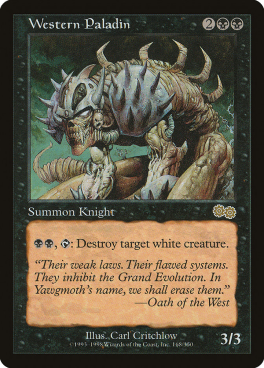



















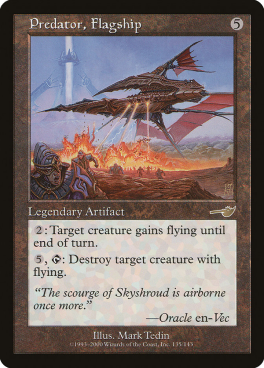






































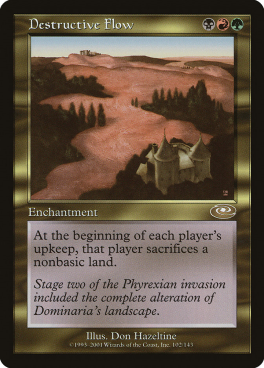





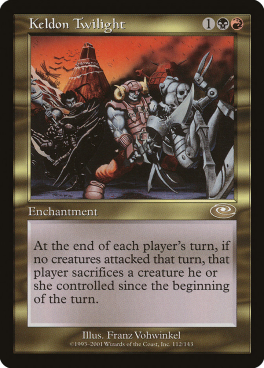





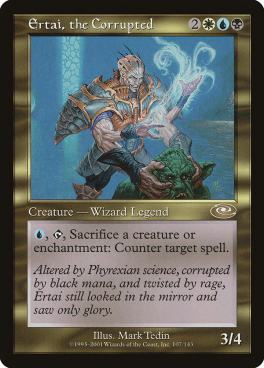












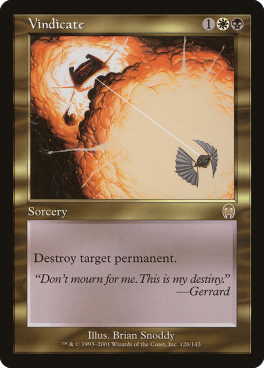

















By the time I started playing Magic around the end of the Odyssey block my friends already talked about the Urza block (Saga in particular) in reverent tones due to its obscene power level. One friend even shelled out for a box of Saga in hopes of cracking a Serra Avatar (not even close to being among the set's most powerful cards, and if memory serves he did not get it). All that to say that Urza block still evokes a bit of that reverence in me today, and I feel a twinge of nostalgia every time I see those gears on the far right of a card.
ReplyDeleteAlso, I have to say that even as a kid Gerrard struck me as being one of the most generic and boring story protagonists I'd encountered. The fact that his legendary card is trash only helped to cement that feeling.
Something else I just remembered is my friends laughing when I asked if there was an Urza card. "They could never make a planeswalker card," they said. "It would be way too powerful." Shows what they knew.
Delete